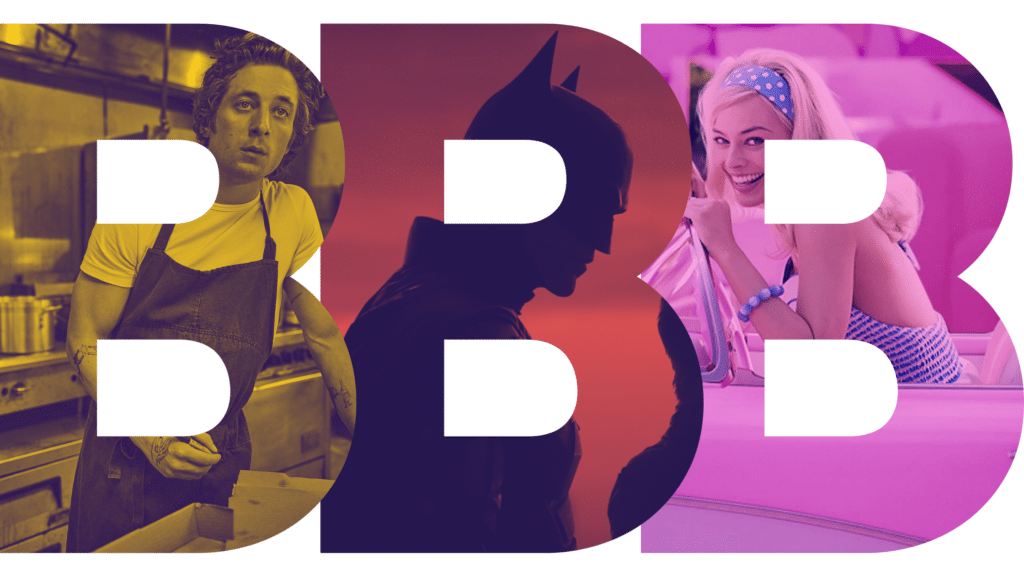
Introduction
Films are stories, chronicling the journey of a set of characters. A journey filled with conflict, varying degrees of relationships, and a fully immersive world. Crafting stories is no mean feat, and it’s important they start off strong.
So, you have an outline for your movie, great characters, and a plot filled with twists and turns. But what makes a strong opening? How can you ensure your story hits the ground running and captivates the audience from the opening scene?
In today’s blog, we’ll outline the strategies you need to craft a killer opening scene to your screenplay. We’ll learn from the best as we explore some examples of the most entrancing film openings around.
Stop staring at your blank page, and let’s get writing!
Why are STRONG openings so important?

Whether you’re writing a short piece of fiction, a novel, poem, or screenplay, the general rule of thumb is to hook your audience. That hook could come in the first line, paragraph, or page. But the truth is, for each and every one, the hook is key!
Think of the opening of your screenplay as a promise to your audience of what’s to come. As screenwriters, we need to deliver a clear picture of a captivating story from page one. Agents, producers and executives reading your script need to be engaged immediately and become invested in your screenplay, so they’ll keep reading.
All of us have closed a book or walked out of a film early at some point in our lives, because we simply didn’t engage with it from the beginning. Think back to a time this happened for you. Can you pinpoint what it was that didn’t quite grab or interest you? Got it? Right, well, this is exactly what we want to avoid.
You’re probably now asking how you can make sure this doesn’t happen to you as a screenwriter? Let’s consider what it means to craft a strong hook.
Crafting a strong hook
Before you write a word on your page, it’s important to have outlined your story from start to finish. While you can just start writing, an outline will help keep you on track. You can always change things as you go.
Know your ending
Be clear on what you want your audience to take from your opening scene. If you don’t know, they certainly won’t. Consider what you want them to know and what feelings do you want to induce in them. We recommend keeping a note of these key elements, so you can refer to them as you write.
If you have already outlined your screenplay, you will know how it will end. A determined end trajectory for a story allows you to stay on track throughout the entire writing process. If you know how the story will conclude, you can ensure your first frame complements your final frame.
Open with your protagonist/antagonist
Your protagonist is the character your audience will follow throughout the entire movie. We see the world through their eyes, so establishing them early will set your story off on the right foot.
There is no rule that says you absolutely must have your protagonist in the opening scene, but if you do, the audience can quickly identify whose point of view will guide them through the story. It also allows them to form an emotional attachment with the protagonist straight away and gives the story narrative focus.
On the flip side, it may serve your script more to start with your antagonist. This sets up the conflict of the story quickly, establishing a clear problem for your protagonist to overcome. This works well for sequels where we’ve already met the main characters and want to introduce their next adversary. This type of opening lends itself well to superhero movies such as Batman and Superman.
Set the scene
The audience needs to know exactly where they are and what’s happening in front of them. Paint a picture that they’re not going to forget in a hurry; like they’re right in the world with your protagonist.
Unlike novels, when establishing setting in a screenplay, you must keep it as concise as possible and stick to the key visuals. Unfortunately, we don’t have the time or page space to write elaborate descriptions of “crisp Fall days with the leaves crunching beneath our feet as we stroll under a cloud-filled sky”. I truly wish we did… but we don’t.
Here is where you lay down the ground rules for your world. This is especially important in the sci-fi and fantasy genres, where the setting you’ve created may not be overly familiar.
Detail core nuggets of information that help build your world’s big picture. We should know where your characters are and the time of day, so we can easily ground ourselves in your story.
Open with action
So far, you’ve introduced your protagonist and setting. But screenplays need action, and in your opening page, it’s wise to establish what is going on quickly. Throw your audience into the midst of the action, and something you’re your protagonist to react too early.
How your characters react to the action taking place in the first scene not only allows you to hit the ground running, but also grabs the audience’s attention and shows them more about the characters and what makes them tick. If we know how your protagonist conducts themselves from page one, we’re more likely to buy into them and their journey.
Opening with action allows you to determine the tone and pace for your script. From here, you can move into the setup of the main story.
Let’s put it all together…
Let’s take the opening scenes of Bond installment Skyfall (2012), which embodies all the elements we just discussed.
Throughout page one, we see Bond as a protagonist immediately, with short and snappy action lines depicting the setting around him. The short lines evoke tension; we’re clearly building up to something. Then BAM, we’re hit with the corpses on the ground, forcing Bond to jump straight into action when he finds a fellow MI-6 agent wounded.
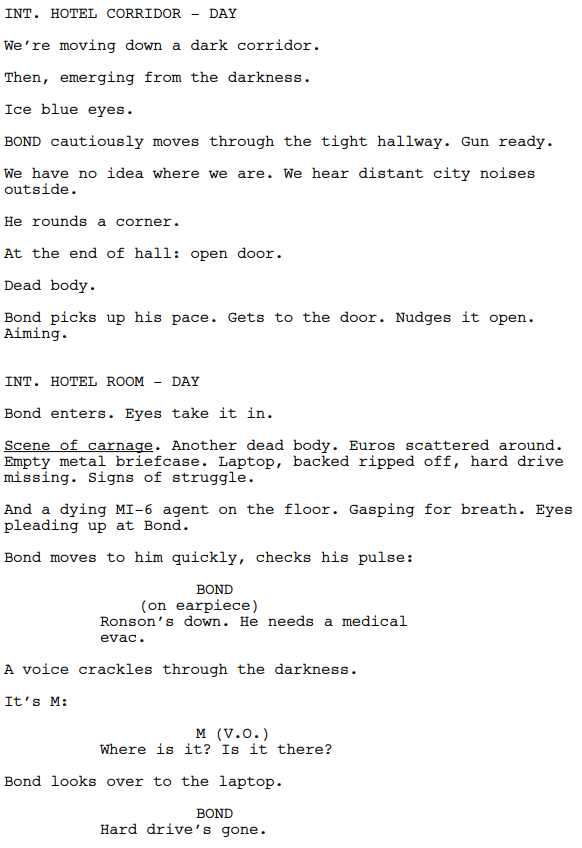
Lessons from specific examples
Now let’s see the theory being put into practice! Here are our top picks of awesome opening scenes from recent years, and how they grab an audience from the start.
The Batman (2022)
You’ll notice this script has a lot more text than Skyfall’s, yet this doesn’t make it any less effective. With The Batman, the writers start by evoking a dark, moody setting, the action flowing continuously as we’re then introduced to our protagonist as a young Bruce Wayne. We are shown that it’s Halloween by the pumpkin candy bucket and costume.
Within seconds, questions are already posed to the audience through the POV of the binoculars. Who is looking through them? Why are they looking into a window where a child is playing fancy dress?
Plus, on the same page, we are given a sense of what’s happening in the wider world, with the Gotham Mayoral Race in full swing.
All within the first two and a half minutes, we know who the characters are, that it’s Halloween, and there’s an upcoming political election. The writers are setting up the conflict to come, and we as the audience want to keep watching to find out exactly what that is.
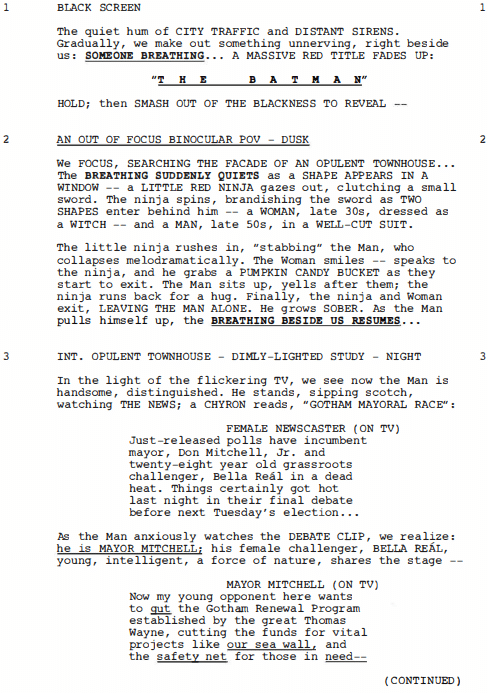
The Bear – Pilot Episode (2022)
The Bear has taken the world by storm since it hit Disney+ just a few years ago. Following the culinary pursuits of chef Carmy, we meet him just after the tragic death of his brother, and face the prospect of taking over his Chicago diner.
A unique blend of comedy and drama, The Bear sets the scene of the city of Chicago at night. We’re immediately introduced to Carmy facing the wrath of a brown bear and trying to calm it down. Or perhaps trying to calm the bubbling conflict inside him?
On page one, we understand Carmy is grappling with something inside, but must bury and placate it to continue with the chaos of life – running The Beef. A foreshadowing of what will come in the next three seasons, as Carmy tries to get The Beef, and himself, back on their feet. As he embarks on this journey, we slowly learn about his personal demons through his familial relationships and his rocky path to culinary success.
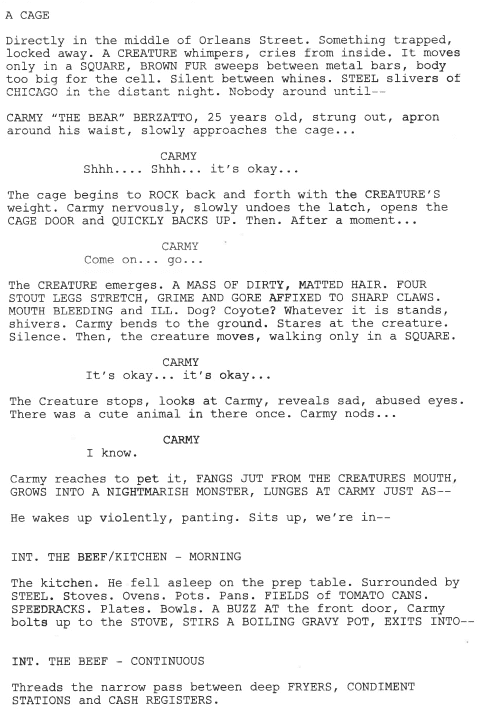
Barbie (2023)
One of the most anticipated movies of 2023, Barbie failed to disappoint. With wit and heart from start to finish, Greta Gerwig’s writing allowed the characters and world to leap off the page.
We open on a scene of girls playing with their dolls, highlighting the focus of the story: empowering women, young and old. It shows Barbie infiltrating the world of toy dolls and girls becoming obsessed with her (if you’d like a more in depth history of Barbie, including the iconic swimsuit from the movie’s opening, check out this awesome article from History.com!).
Doubly, this opening scene introduces us to Margot Robbie’s Barbie (the protagonist) and how she started the world of Barbie as she enters the white space, which is soon to become the pink wonderland we get to know and love soon after.
Gerwig’s voice is clear from this first page, injecting humor not just into the dialogue, but in the way she describes the action.
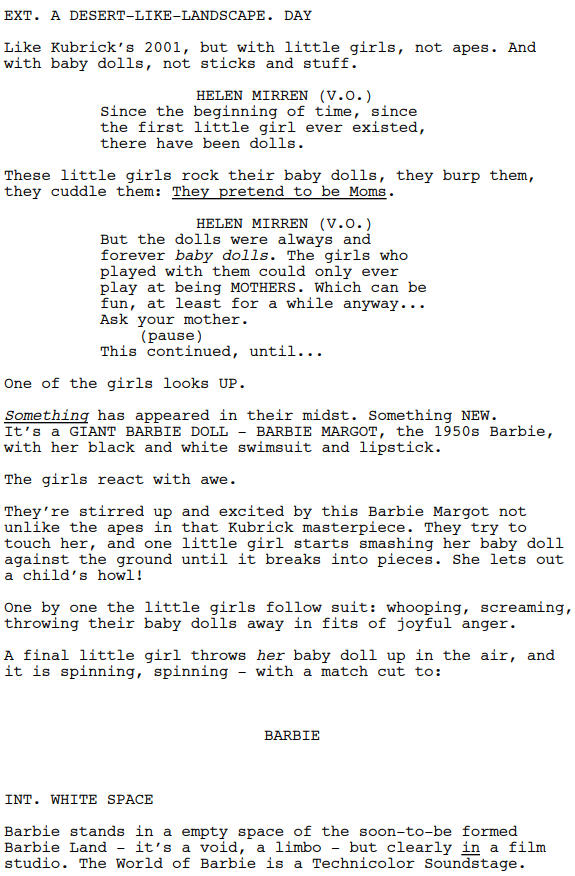
Applying these techniques to your work
If you’re struggling with your opening scene, or even if you’re not, a fantastic way to spark some inspiration is by watching some of your favorite opening scenes from movies and TV shows with the first page in front of you.
Take notes as you watch and read. How does the opening scene make you feel as a viewer? What can you deduce from the first scene, and how does what you discover link to moments later in the story?
Additionally, I’d recommend doing this for films and TV shows you haven’t seen yet. This gives you a fresh perspective on the story, and without any prior knowledge of what happens. Once you’ve taken your notes, watch the rest of it, and see how the opening scene links.
Whilst I never encourage completely copying a writer’s style and to always develop your own voice, if you like a specific way a writer had introduced a character or set a scene, try and rework it into your own story. This can work especially well if the inspired work is in the same genre.
My biggest piece of advice for writing an opening, however, is to not overthink it too much. It is ten times easier to edit something than to write it. If you spend too much time mulling over something, it’ll never be written. Start with your first idea, and you can always come back and adapt and change it later.
Why not use Celtx to help craft your killer opening? Take us anywhere with our cloud-based software designed for screenwriters – perfect for when you get that spark of inspiration or need to collaborate.
Conclusion
Crafting a strong opening is crucial to capturing your audience’s attention and setting the tone for the rest of your screenplay. By outlining your story, introducing your protagonist or antagonist, setting the scene, and jumping into action, you can create an engaging hook that leaves readers and viewers wanting more. As we’ve seen from recent hits like The Bear, The Batman, and Barbie, a compelling opening lays the groundwork for the narrative, draws the audience in, and sets up the conflict and stakes. So, start strong, trust your instincts, and refine your first scene until it shines.
Everyone has a story to tell — Celtx can help you tell yours. Get started today!
